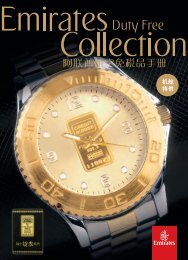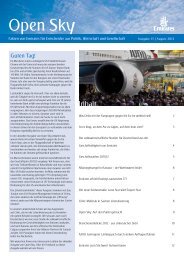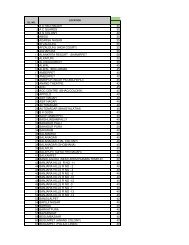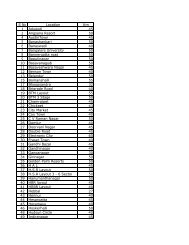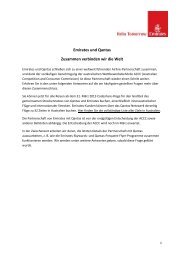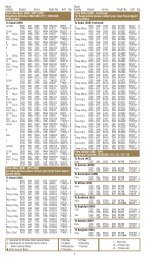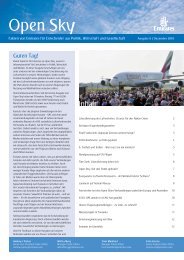Annual Report 2008-2009 - Emirates.com
Annual Report 2008-2009 - Emirates.com
Annual Report 2008-2009 - Emirates.com
Create successful ePaper yourself
Turn your PDF publications into a flip-book with our unique Google optimized e-Paper software.
35. Financial risk management<br />
Financial risk factors<br />
<strong>Emirates</strong> is exposed to a variety of financial risks which involve the analysis, evaluation, acceptance and management of some<br />
degree of risk or <strong>com</strong>bination of risks. <strong>Emirates</strong> aim is, therefore, to achieve an appropriate balance between risk and return and<br />
minimise potential adverse effects on <strong>Emirates</strong>' financial performance.<br />
<strong>Emirates</strong> risk management procedures are designed to identify and analyse these risks, to set appropriate risk limits and controls,<br />
and to monitor the risks and adherence to limits by means of reliable and up-to-date information systems. <strong>Emirates</strong> regularly<br />
reviews its risk management procedures and systems to reflect changes in markets, products and emerging best practice. <strong>Emirates</strong><br />
uses derivative financial instruments to hedge certain risk exposures.<br />
Risk management is carried out by corporate treasury under procedures that are approved by a steering group <strong>com</strong>prising of senior<br />
management. Corporate treasury identifies, evaluates and hedges financial risks in close cooperation with the operating units.<br />
Senior management is also responsible for the review of risk management and the control environment. The most important types<br />
of risk are credit risk and concentrations of risk, market risk and liquidity risk. Market risk includes currency risk, interest rate risk and<br />
price risk.<br />
(i) Credit risk<br />
<strong>Emirates</strong> is exposed to credit risk, which is the risk that the counterparty will cause a financial loss to <strong>Emirates</strong> by failing to discharge<br />
an obligation. Financial assets that potentially subject <strong>Emirates</strong> to credit risk consist principally of deposits with banks and other<br />
financial institutions, derivative counterparties as well as receivables from agents selling <strong>com</strong>mercial air transportation. <strong>Emirates</strong> uses<br />
external ratings such as Standard & Poor's and Moody's or their equivalent in order to measure and monitor its credit risk<br />
exposures to financial institutions. In the absence of independent ratings, credit quality is assessed based on counterparty's<br />
financial position, past experience and other factors.<br />
<strong>Emirates</strong> manages limits and controls concentrations of risk wherever they are identified. In the normal course of business, <strong>Emirates</strong><br />
places significant deposits with high credit quality banks and financial institutions. Transactions with derivative counterparties are<br />
similarly limited to high credit quality financial institutions. Exposure to credit risk is also managed through regular analysis of the<br />
ability of counterparties and potential counterparties to meet their obligations and by changing their limits where appropriate.<br />
Approximately 23% (<strong>2008</strong>: 25%) of short term bank deposits, cash and cash equivalent and held-to-maturity financial assets are<br />
held with financial institutions under <strong>com</strong>mon control. Approximately 92% (<strong>2008</strong>: 81%) of cash and bank balances are held with<br />
financial institutions based in the UAE.<br />
The sale of passenger and cargo transportation is largely achieved through International Air Transport Association (IATA) approved<br />
sales agents. All IATA agents have to meet a minimum financial criteria applicable to their country of operation to remain<br />
accredited. Adherence to the financial criteria is monitored on an ongoing basis by IATA through their Agency Programme. The<br />
credit risk associated with such sales agents is relatively small owing to a broad diversification.<br />
The table below presents an analysis of short term bank deposits, cash and cash equivalents and held-to-maturity financial assets<br />
by rating agency designation at the balance sheet date based on Standard & Poor's ratings or its equivalent for the main banking<br />
relationships:<br />
<strong>2009</strong> <strong>2008</strong><br />
AED'000 AED'000<br />
AA- to AA+<br />
3,246,404<br />
723,097<br />
A- to A+<br />
3,439,137<br />
8,949,915<br />
Lower than A- 194,414<br />
437,823<br />
107





